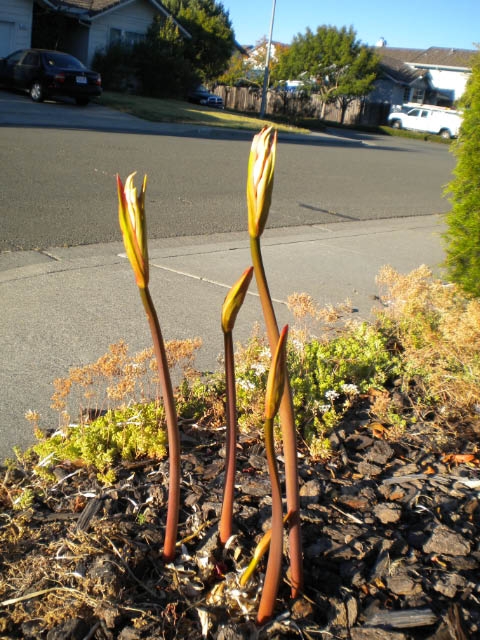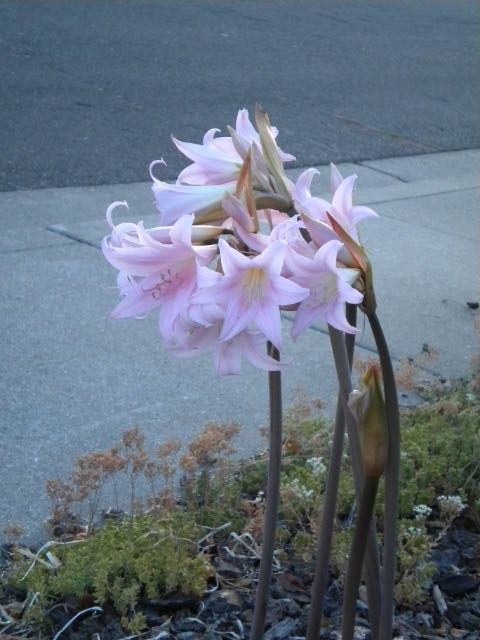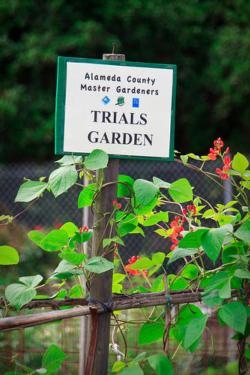Posts Tagged: Master Gardeners
They're Naked in the Garden!
I've always been enchanted with Naked Ladies, the pale pink flowers that seem to magically appear in late summer. Several years ago they were offering bulbs at a Master Gardener Plant Exchange. I picked up one of the coconut sized bulbs and decided to give it a try.
I did some research and found the experts said the bulbs didn't like to be moved so it might be a while before they bloomed. Okay... Next year lovely strap like leaves, but no flowers. Ditto for year number two. This year, lovely spring leaves that died to the ground, and then, in August , stalks with large terminal bulbs seemed to appear overnight. The stalks shot up rapidly then beautiful pink flowers unfurled.
The common name, Naked Ladies, comes from the fact that there are no leaves present when they bloom. The plant is also known as Pink Lady, Resurrection Lily and Magic Lily. It's not a lily, but is in the Amaryllis family. I'm just happy the ladies finally arrived!

Naked Ladies, before. (Photo by Karen Metz)

Naked Ladies, after. (Photo by Karen Metz)
Farm subsidies' connection to obesity debated
Some experts say federal farm subsidies contribute to the nation's obesity crisis, reports Marni Jameson in the Chicago Tribune. They argue that corn and wheat, the most heavily subsidized crops, are also staples in a variety of common, fattening, nutrition-deficient foods. But UC agricultural economist Julian Alston says farm subsidies are unrelated to obesity. "I get annoyed because everyone points to farm subsidies as one of the top two reasons for the obesity epidemic, but it's irrelevant," Alston said. He believes the elimination of farm subsidies would have a negligible effect on obesity rates.
Master Gardeners ready to help
Karen Rifkin, The Willits News
In a general feature story about the Mendocino County Master Gardener program, volunteer Wendy Roberts was quoted: "Master gardeners are trained volunteer staff of the University of California Cooperative Extension. They are members of the local community who share a common interest in and love of the growth and care of plants and provide practical, scientific horticulture and gardening information to the citizens of Mendocino County."

If farm subsidies have contributed to America's obesity epidemic, the impact has been slight and indirect.
Welcome Gardeners!
Thank you for joining the Master Gardeners (MGs) as they share with you their knowledge and experiences of gardening in Solano County.
If you aren’t familiar with our program, let me fill you in. The MGs are residents of Solano County. They are a diverse group of people who have been trained in horticulture for the purpose of volunteering their time to share that knowledge with you, the home gardener.
Each weekday, this blog will cover a new topic, something of interest to the writer or an interesting tidbit he or she has discovered in his or her home gardens or in other parts of our county.
We are excited about sharing this blog with you and hope you enjoy reading about everything Under the Solano Sun.
Alameda Master Gardeners help develop garden to feed the hungry
In addition, plans are in place to make the organic planting and composting operation a demonstration garden with a monthly curriculum and teaching cycles for anyone who wants to learn about gardening, the story said.
The pastor of Asbury United Methodist Church, Chuck Johnstone, suggested last year that open land behind the church could be used to grow food for the hungry. In August, Alameda County Master Gardeners Bruce Campbell and Mark Brunell and a team of volunteers prepared the soil for planting by digging down 18 inches by hand, screen-sifting the soil to remove the pebbles and rocks, and forming five 80-foot-long raised beds. In December they held a four-hour planting party.
"We're doing all this on a shoestring. We replaced a large cash outlay with a lot of (volunteer) labor," Campbell was quoted in the article.
Reporter Thomas Petty said the Master Gardeners have two simple goals for the garden:
- Use an organic market garden model. Food scraps from the food kitchen are composted and put back into the garden for fertilizer. No artificial fertilizers or pesticides are used and the group is working toward "bio-intensive" beds.
- Have a closed system in which proper crop rotation increases soil fertility. Nothing goes into the system except sun, water and compost.
The Garden of Grace blog reported that 50 heads lettuce - romaine, green and red salad bowl, red sails lettuce, and some Russian red kale leaves - 12 broccoli heads, 6 Bull's Blood beets, and 6 turnips were harvested from the garden on Easter Sunday.
Master Gardener project one of high-brow food editor's picks
At the end of a lengthy list of hoity-toity restaurants and upscale events published in the Los Angeles Daily News this week, the writer slipped in a road trip to the Great Park Farm and Food Lab in Orange County, where educational gardens are maintained by UC Cooperative Extension Master Gardeners.
After dishing about the five-spice braised pork belly with star anise served at Rama, seitan meatballs with tomato ginger curry at Mana's on Maple, and a $150 per person fundraiser at the Ritz-Carlton, food editor Natalie Haughton plugs the lab's pizza and spaghetti garden, where people can see vegetables growing before they are chopped into marinara sauce.
The Farm and Food Lab features planters brimming with fruits, flowers, vegetables and herbs. There are 12 themed garden beds - including an ethnic garden, fruit salad garden, herb garden and sensory garden - that introduce kids and adults to new and interesting produce and plant life.
The lab is only a small part of the Great Park's venture into urban agriculture. Planners have set aside 114 acres of the former El Toro Marine Corps. Air Station to be cultivated with food crops for the first time since James Irvine sold his lima bean fields to the U.S. government 70 years ago.

An herb garden in the Farm & Food Lab in Orange County.



